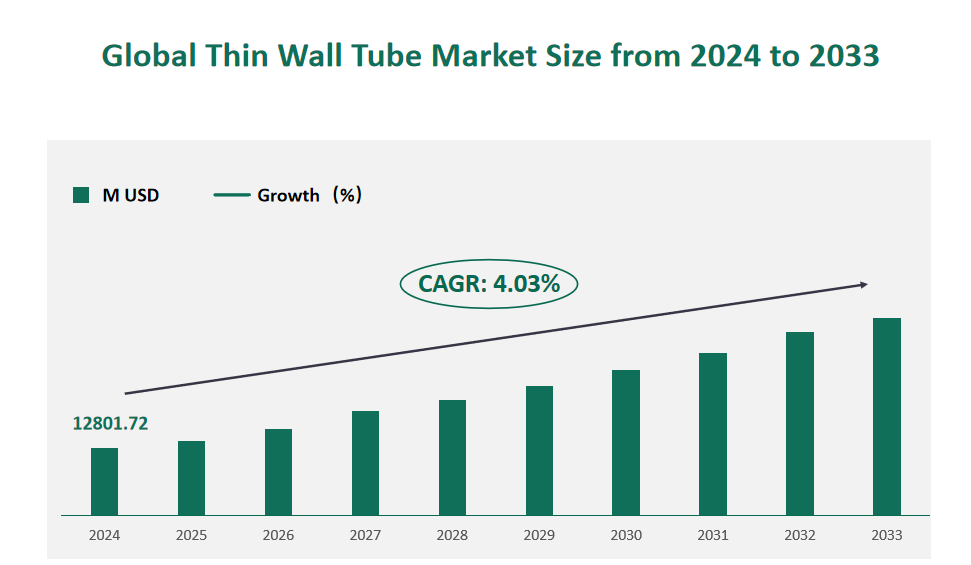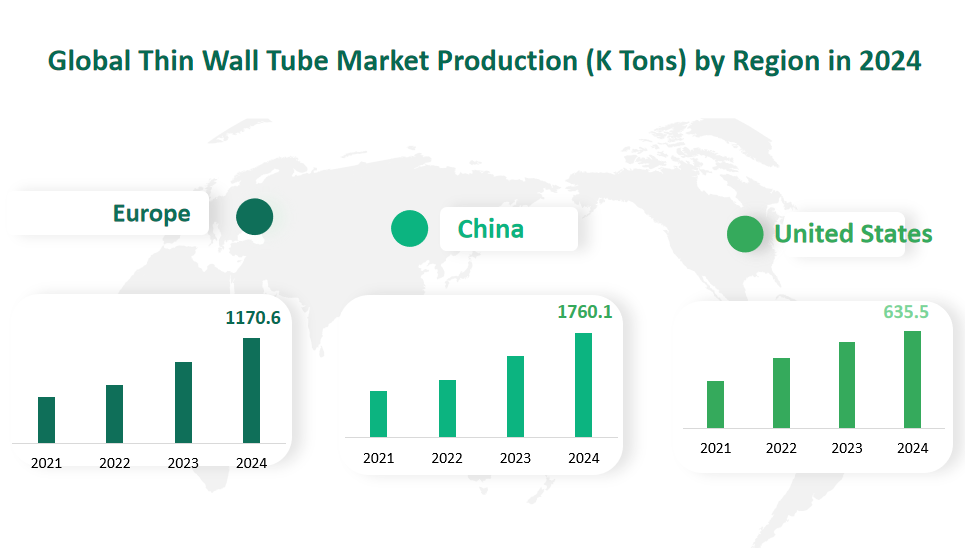1 Global Thin Wall Tube Market Size (Value) and CAGR (2024-2033)
The global thin wall tube market is anticipated to experience a compound annual growth rate (CAGR) of 4.03% from 2024 to 2033. In 2024, the total market value is forecasted to reach $12,801.72 million USD, showcasing a robust expansion in the coming years.
A thin wall tube refers to a hollow, open-ended member whose diameter are much larger than its wall thickness. Usually, thin wall tubing is made with a wall thickness to diameter ratio of less than 6%. Moreover, thin wall tubes can be fabricated from metals such as stainless steel, aluminum, steel, copper, alloy, etc.
Figure Global Thin Wall Tube Market Size (M USD) and CAGR 2024-2033

2 Drivers and Opportunities in the Thin Wall Tube Market
The Thin Wall Tube market is experiencing robust growth, propelled by a multitude of drivers and opportunities. One of the primary drivers is the increasing demand from a variety of industries, particularly automotive, aerospace, energy, mechanical, and medical sectors. These industries require thin wall tubes for their precision and strength, leading to a surge in market demand. The growing global population and economic development have further amplified this demand, creating a favorable environment for market expansion.
Technological advancements have also played a significant role in driving market growth. Additive manufacturing, or 3D printing, has emerged as a game-changer, offering new possibilities for the production of thin wall metal tubes. This technology allows for the creation of precise metal products, simplifying the manufacturing process and reducing material waste, which is a significant opportunity for the industry.
Another opportunity lies in the growing e-commerce industry. The rise of online shopping has led to an increase in demand for thin wall tubes, as e-commerce platforms require these tubes for various applications. The convenience of online distribution has also allowed manufacturers to reach a broader customer base, offering quality products at competitive prices.
3 Limitations in the Thin Wall Tube Market
Despite the promising growth, the Thin Wall Tube market faces certain limitations that could hinder its progress. One of the main challenges is the volatility in raw material prices. Commodities such as steel, aluminum, copper, and other metals used in the production of thin wall tubes have experienced significant price fluctuations. These fluctuations can adversely affect the cost of sales, profitability, and the ability of manufacturers to meet customer demand. The industry’s reliance on these raw materials makes it susceptible to global supply and demand changes, tariffs, exchange rates, and geopolitical tensions.
Fierce competition is another limitation. With a large number of suppliers offering similar products, the market is highly competitive, which can lead to price wars and reduced profit margins. This competition also raises the barriers to entry for new players, making it difficult for them to establish a foothold in the market.
4 Global Thin Wall Tube Market Size by Type in 2024
The global thin wall tube market is characterized by a diverse range of materials used in the construction of these tubes, each serving specific industry needs. In 2024, the market value for different types of thin wall tubes is anticipated to reflect the varying demands and applications of these materials.
Steel Material: This category encompasses a variety of steel tubes, including carbon steel, low alloy steel, and alloy steel, which are suitable for general structural and mechanical components. Additionally, thin wall fluid steel tubes are used for conveying general fluids, while stainless steel thin wall tubes find application in industries such as chemical, petroleum, light industry, food, and mechanical instruments for industrial heat-resistant containers and pipes. In 2024, the market value for steel material thin wall tubes is projected to reach $10,826.6 million.
Metallic Material: Metallic material thin wall tubes are fabricated from metals such as aluminum, copper, titanium, and brass. These tubes are made from different metal alloys and high-strength metals, which are not easily broken or deformed. They are known for their durability and strength, making them ideal for applications where resistance to deformation and high strength are required. The market value for metallic material thin wall tubes in 2024 is estimated to be $1,975.12 million.
Table Global Thin Wall Tube Market Size by Type in 2024
| Type | Market Size (M USD) 2024 |
| Steel Material | 10826.60 |
| Metallic Material | 1975.12 |
5 Global Thin Wall Tube Market Size by Application in 2024
The global Thin Wall Tube market is segmented into various applications, each contributing significantly to its growth. In 2024, the market value for different applications of thin wall tubes is expected to reflect the diverse needs and technological advancements across industries.
Automotive: Thin wall tubes play a crucial role in the automotive industry, particularly in fuel lines, wiring harnesses, and other engine-related processes. The market value for automotive applications is projected to reach $7,658.26 million in 2024.
Aerospace: In the aerospace sector, thin wall tubes are deployed in aircraft engines and airframes, used for flight control surfaces and landing gear. The market value for aerospace applications is estimated to be $820.11 million in 2024.
Energy: Thin wall tubes are used in the energy industry, particularly in nuclear power and electric power for condenser tubes. The market value for energy applications is anticipated to reach $972.42 million in 2024.
Mechanical: In the mechanical industry, thin wall tubes are utilized for their bending properties in flexible applications. The market value for mechanical applications is expected to reach $1,400.51 million in 2024.
Medical: The medical field requires thin wall tubes for precision in operations, with applications in catheters, lab instruments, and surgical tools. The market value for medical applications is projected to be $643.45 million in 2024.
Table Global Thin Wall Tube Market Size by Application in 2024
| Application | Market Size (M USD) 2024 |
| Automotive | 7658.26 |
| Aerospace | 820.11 |
| Energy | 972.42 |
| Mechanical | 1400.51 |
| Medical | 643.45 |
| Others | 1306.96 |
6 Global Thin Wall Tube Market Production (K Tons) by Region in 2024
The global thin wall tube market is distributed across various regions, each with its own production capabilities and market dynamics. In 2024, the production of thin wall tubes is expected to reflect the regional strengths and industry focus.
United States: With a mature market and strong demand, the US is expected to produce 635.5 K Tons of thin wall tubes in 2024.
Europe: As a significant market with a well-established industrial base, Europe’s production is projected to reach 1170.6 K Tons in 2024.
China: Being the largest market with strong downstream demand, China’s production is anticipated to be 1760.1 K Tons in 2024.
Japan: With a focus on high-quality production, Japan’s production is expected to reach 601.1 K Tons in 2024.
Middle East and Africa: These regions are considered potential markets with growing demand, Estimated production is 208.5 K Tons in 2024.
India: As an emerging market with increasing industrialization, India’s production is projected to be 288.3 K Tons in 2024.
South America: With growing potential in industrial applications, South America’s production is expected to reach 292.9 K Tons in 2024.
Figure Global Thin Wall Tube Market Production (K Tons) by Region in 2024

7 Major Players in Global Thin Wall Tube Market
7.1 Salzgitter
Company Profile: Salzgitter AG, established in 1858 and headquartered in Germany, is one of the largest steel producers in Europe. The company operates through five divisions: Steel, Trading, Tubes, Services, and Technology, with a global presence.
Business Overview: Salzgitter AG specializes in the manufacturing of steel and associated products, including heavy profile steel sheets, hot-rolled wide strips, and steel strips. The group is known for its extensive product range and commitment to quality.
Product Introduction: Salzgitter offers welded and drawn precision steel tubes with high dimensional accuracy, minimal eccentricity, and smooth drawn surfaces. These tubes are used in various applications due to their increased strength values derived from cold forming.
Financial Snapshot 2022: Salzgitter recorded a revenue of $306.31 million in 2022, with a gross margin of 18.43%.
7.2 JFE Steel Corporation
Company Profile: JFE Steel Corporation, established in 2003 and based in Japan, is the result of the merger between Kawasaki Steel and NKK (Nihon Kokan). It is the second-largest Japanese steel manufacturer and is part of JFE Holdings.
Business Overview: JFE Steel is known for its pioneering development of a wide variety of steel pipe products, including thin wall tubes, through continuous technological innovation. The company caters to various industries with carbon steel and stainless steel products.
Product Introduction: JFE Steel’s product lineup includes thin wall tubes optimized for specific applications across different industries, showcasing the company’s commitment to meeting diverse customer needs.
Financial Snapshot 2022: With a revenue of $284.25 million in 2022, JFE Steel Corporation achieved a gross margin of 20.08%.
7.3 Baoyin Special Steel Tube
Company Profile: Baoyin Special Steel Tube, established in 1991 and headquartered in China, is a national high-tech enterprise specializing in the research, development, and manufacture of special pipes for nuclear power, thermal power, petrochemical, rail transit, aerospace, and military fields.
Business Overview: Baoyin leverages the resource advantages of central enterprises and the flexibility of private enterprises to offer a wide range of special steel pipes, including thin wall tubes, for critical applications.
Product Introduction: The company’s thin wall tubes are used in nuclear reactors, pressure vessels, and heat exchangers, among other applications, highlighting the importance of their precision and quality in high-stakes industries.
Financial Snapshot 2022: Baoyin Special Steel Tube reported a revenue of $264.76 million in 2022, with a gross margin of 23.43%.

